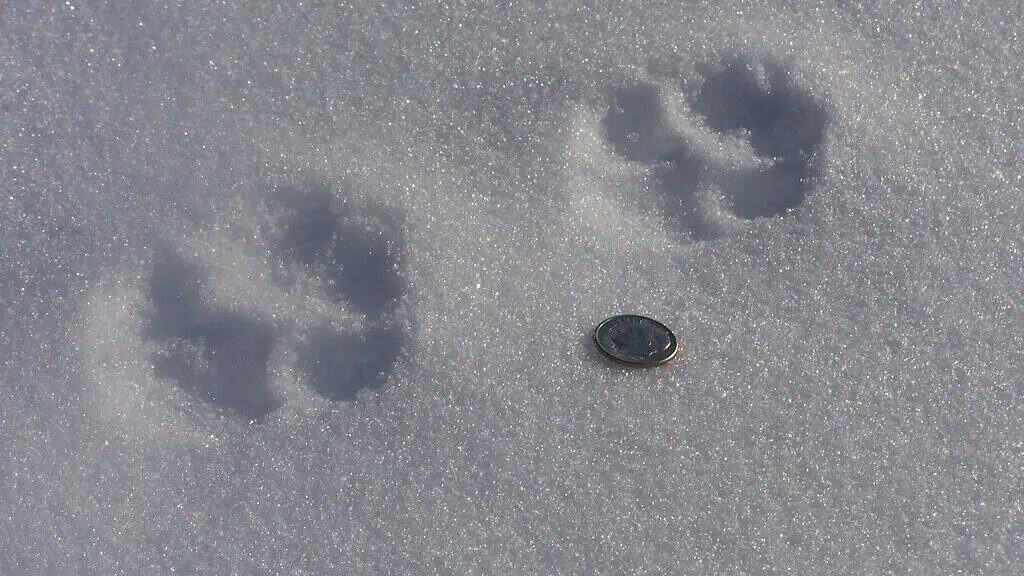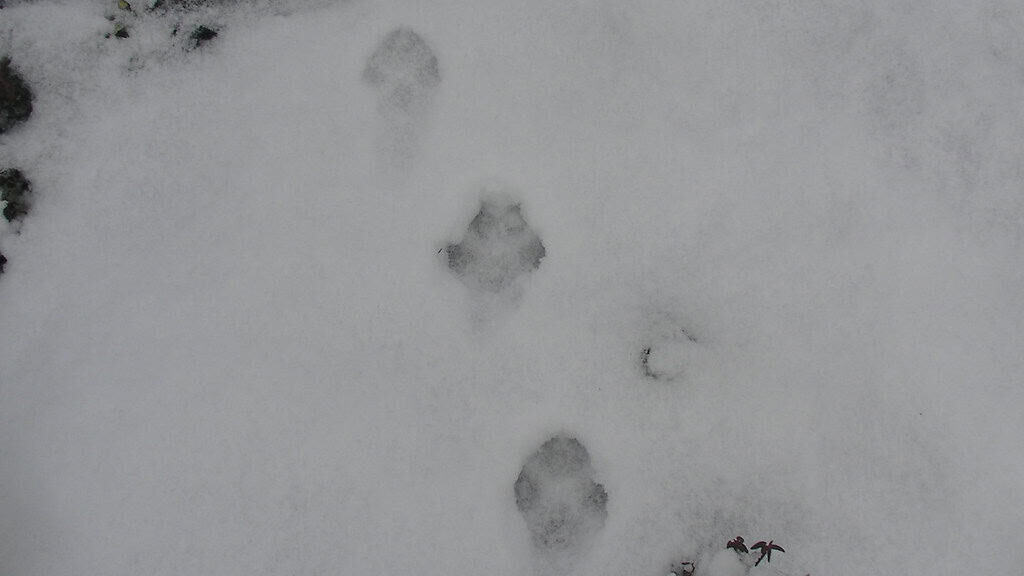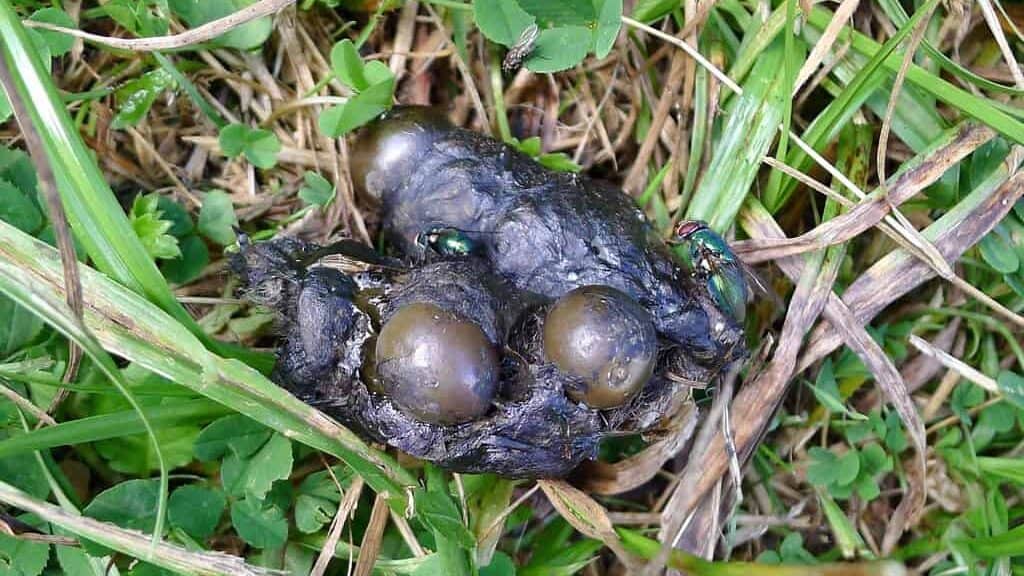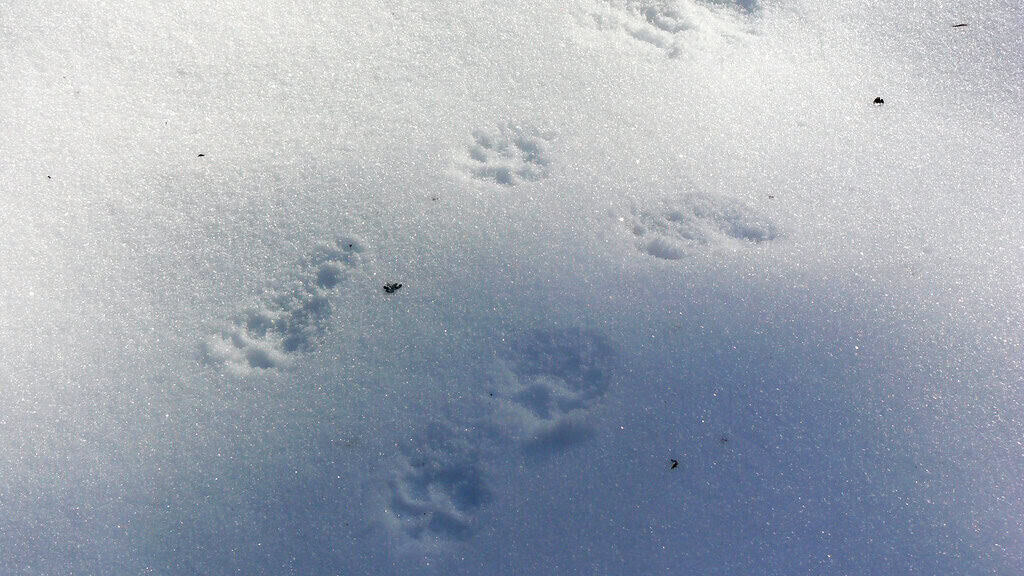Fox tracks in your yard can reveal fascinating information about these elusive creatures that share our neighborhoods. Similar to dog prints but more compact and oval-shaped, fox tracks typically measure about 2 inches long by 1.5 inches wide. The defining characteristic that separates fox tracks from other canids is the diamond-shaped impression and the clear X pattern formed between the paw pads and toes when viewed from above. Unlike dogs, foxes have relatively small pads compared to their overall track size, and they often leave claw marks that are thin and pointed rather than blunt.
Another distinguishing feature is the directness of fox movements. Foxes are efficient travelers, and their tracks frequently appear in a nearly straight line, with each paw print falling almost directly in front of the previous one—a walking pattern called “direct register.” This walking style, where the hind foot steps precisely into the print left by the front foot, creates a neat, single line of tracks that looks as if the animal was walking on a tightrope. This energy-conserving gait is particularly noticeable in snow or mud where clear impressions are left behind.
Distinguishing Red Fox From Gray Fox Tracks

While North America is home to both red foxes (Vulpes vulpes) and gray foxes (Urocyon cinereoargenteus), their tracks have subtle differences that can help you identify which species is visiting your yard. Red fox tracks tend to be more oval-shaped and slightly larger, measuring between 1.75 to 2.5 inches long. Their prints often show more fur impressions around the pads, especially in winter when their foot fur is thickest. The negative space between the pads often creates a distinctive “chevron” or V-shape at the front of the track.
Gray fox tracks, on the other hand, are typically more compact and rounded, measuring between 1.25 to 1.75 inches long. Their tracks sometimes show less distinct toe impressions and have a more symmetrical appearance. Gray fox tracks may also reveal hints of their semi-retractable claws, which help them climb trees—a unique ability among North American canids. If the tracks lead up a tree or along a fallen log, you’re almost certainly dealing with a gray fox rather than a red fox, which typically stays on the ground.
Track Patterns: What Fox Gaits Reveal

Fox tracks don’t just tell you which species visited—they also reveal the animal’s behavior and intentions through their gait patterns. When foxes move at a walking pace, they often use the direct register walk, placing their hind feet in the impressions made by their front feet. This creates a seemingly single line of prints, giving the impression that the fox is walking on two legs rather than four. This energy-efficient gait is commonly seen when foxes are casually patrolling their territory or searching for food without urgency.
When foxes pick up speed, their track patterns change dramatically. A trotting fox leaves a diagonal pattern of prints, with front and opposite hind paws striking the ground simultaneously. At full sprint, foxes use a bounding or galloping gait that leaves groups of four prints close together, followed by a longer space before the next group. This pattern indicates the fox was likely startled, chasing prey, or feeling threatened. Circular patterns of tracks might indicate the fox was hunting, investigating an interesting scent, or listening for rodents beneath the snow in a behavior called “mousing,” where they pounce headfirst into snowdrifts to catch hidden prey.
Seasonal Variations in Fox Track Appearances

Fox tracks change appearance throughout the year, reflecting seasonal adaptations and behavioral shifts. Winter tracks often appear larger and less defined because foxes grow thicker fur between their toes and pads during cold months—a natural snowshoe adaptation that helps distribute their weight and provides insulation. This extra fur can make winter tracks look fuzzy around the edges or partially filled in. During this season, you might also notice tracks showing a fox’s tail drag in deep snow, appearing as a continuous line between the paw prints.
Summer tracks tend to be more clearly defined, showing distinct pad and toe impressions without the fuzzy edges. During warmer months, foxes also change their movement patterns and territory use, often traveling along established trails to conserve energy. Spring tracks might reveal mating behaviors with pairs of tracks running parallel, while late spring and summer may show smaller tracks of young foxes learning to hunt alongside adults. These juvenile tracks are similar in shape to adult prints but notably smaller and often show less direct movement patterns as young foxes explore their surroundings with typical youthful curiosity.
Trail Patterns: The Stories They Tell

The arrangement of fox tracks across your yard can reveal compelling narratives about their activities. A straight line of evenly spaced tracks indicates purposeful travel, suggesting the fox is moving between hunting grounds, water sources, or den sites. These direct paths often follow the boundaries of properties, fences, or natural features—foxes are territorial animals that regularly patrol and mark their domains. If these straight-line tracks appear consistently in your yard, you’re likely on a regular fox commuting route.
More scattered, meandering tracks tell a different story. These irregular patterns suggest the fox was actively hunting or investigating interesting scents. You might notice places where tracks suddenly change direction or cluster around a specific area—these often indicate points where the fox detected prey. Particularly distinctive are the pouncing patterns, where tracks suddenly end and then reappear a distance away with a small disturbed area in between, showing where the fox leaped to catch prey. Circle patterns might indicate “mousing” behavior, where the fox uses its sensitive hearing to locate small mammals beneath snow or vegetation before pouncing.
What Fox Scat Near Tracks Reveals

Finding fox scat (droppings) near tracks provides valuable additional information about your vulpine visitor. Fox scat is typically 2-4 inches long, dark in color, and rope-like with a characteristic twisted appearance and a pointed end. Unlike coyote or dog scat, fox droppings often contain clearly visible evidence of their diet: fur, feathers, bone fragments, berry seeds, and insect parts. The contents of the scat can tell you what food sources the fox is utilizing in your neighborhood and may change seasonally as different foods become available.
The placement of fox scat is equally informative. Foxes use scat as territorial markers, often depositing them in prominent locations like rocks, logs, or the center of trails. Finding scat deliberately placed on elevated objects near tracks indicates territorial marking behavior rather than random elimination. Fresh scat near tracks means the fox has recently claimed your yard as part of its territory. The frequency and placement of these scent markers can indicate whether your yard is at the center or periphery of a fox’s territory, with more frequent marking typically occurring at territorial boundaries where different fox families’ ranges meet.
Tracking Fox Behavior Around Structures

Fox tracks around human structures can provide insights into how these adaptable predators interact with our built environment. Tracks that run along the foundations of sheds, decks, or porches might indicate the fox is seeking shelter, investigating potential den sites, or hunting for mice and other small mammals that live in these spaces. Particularly in winter or early spring, tracks that repeatedly lead to the same protected area under a deck or outbuilding might suggest the fox is considering this location for a natal den where it will raise its young.
Tracks around compost piles, gardens, or fruit trees reveal opportunistic feeding behavior. Foxes are omnivorous and will readily consume fallen fruit, garden vegetables, compost scraps, and the rodents attracted to these food sources. If you notice fox tracks circling your chicken coop or rabbit hutch, take precautions—while foxes are beneficial predators of rodents, they won’t hesitate to take poultry or small domestic animals if given the opportunity. Tracks that show a fox lingering around pet food dishes or garbage areas indicate the fox may be becoming habituated to human-provided food sources, a situation best discouraged for the long-term health of the animal.
Seasonal Fox Activities Revealed Through Tracking

Fox track patterns change throughout the year, reflecting the seasonal activities crucial to their life cycle. In late winter (January-February), you might notice pairs of tracks running parallel—this breeding season activity shows foxes traveling together as they form mating pairs. By early spring (March-April), tracks leading repeatedly to secluded areas under sheds, within brush piles, or in abandoned burrows often indicate den establishment for raising kits. Female foxes become particularly secretive during this time, and tracks might show more direct movement as they efficiently travel between hunting grounds and the den.
By late spring and early summer, you might discover smaller tracks alongside adult prints as young foxes begin exploring beyond the den. These family group patterns typically show more playful, erratic movements compared to the purposeful tracks of adults. Late summer and fall tracks often reveal more scattered hunting patterns as foxes build fat reserves for winter and young foxes disperse to establish their own territories. Winter tracking shows a return to energy-conserving movements and more reliance on established trails as foxes adapt to challenging conditions. The concentration of tracks around potential food sources often increases during this time of scarcity.
Urban vs. Rural Fox Track Differences

Fox tracks in urban and suburban environments often tell a different story than those in rural settings. Urban fox tracks typically show more irregular patterns, with frequent changes in direction as these adaptable animals navigate the complex landscape of human development. These tracks often follow human infrastructure like fences, walkways, and building edges as foxes use these features as travel corridors. Urban fox prints might also appear more frequently around human food sources like garbage areas, compost bins, and locations where people feed outdoor pets or wildlife.
Rural fox tracks, by contrast, typically follow more natural patterns, with direct travel along game trails, field edges, and natural boundaries. These tracks often show more consistent hunting behaviors, following the edge habitat where field meets forest—prime hunting grounds for rodents. Rural fox movements generally cover larger territories than their urban counterparts, who adapt to smaller, more resource-dense ranges. Interestingly, research shows that urban foxes often develop more complex social structures than rural foxes, sometimes living in small family groups rather than as solitary animals or pairs—a behavior adaptation that might be reflected in more overlapping track patterns in urban environments.
Fox Tracks and Local Ecosystem Health

The presence of fox tracks in your yard can serve as an indicator of local ecosystem health and biodiversity. As mesopredators—mid-sized predators occupying the middle of the food web—foxes require adequate prey populations to sustain themselves. Regular fox tracks suggest healthy populations of rodents, rabbits, insects, and other small animals that make up their diverse diet. The patterns of these tracks can reveal which prey species are active in your area; tracks that show hunting behavior around specific habitat features like stone walls, brush piles, or meadow edges indicate these areas are supporting the small mammals foxes target.
Fox presence also contributes to ecosystem balance by controlling rodent populations that might otherwise damage gardens or spread disease. Tracking how fox movements change in your yard over time can provide insights into shifting local ecological conditions. For instance, a sudden increase in fox activity might indicate a boom in prey populations, while a decrease could suggest habitat disturbance or competition from other predators like coyotes. By observing and recording fox tracks across seasons and years, you’re gathering valuable data about your local ecosystem’s health and functioning—information that connects your yard to the larger web of urban or rural wildlife.
When Fox Tracks Indicate Potential Conflicts

While fox presence is generally beneficial, certain track patterns might signal potential human-wildlife conflicts. Tracks that repeatedly approach chicken coops, rabbit hutches, or areas where small pets are kept indicate the fox has identified these as potential food sources. Similarly, tracks showing a fox regularly visiting areas where pet food is left outside suggest habituation to human-provided food. If you notice these patterns, securing livestock, bringing pet food indoors at night, and installing motion-activated lights can help prevent conflicts before they develop.
Fox tracks that lead directly to or from spaces under decks, sheds, or other structures may indicate den establishment—particularly concerning in spring when foxes seek secure locations for raising young. While a fox family can be fascinating to observe, having a den too close to human activity can lead to problems for both people and foxes. If tracks suggest denning behavior in an unsuitable location, early intervention with humane deterrents like ammonia-soaked rags, motion-activated sprinklers, or talk radio played near the site can encourage the fox to relocate before it becomes too established, avoiding the need for more drastic measures later.
Fox tracks in your yard offer a window into the secret lives of these adaptable, intelligent predators that increasingly share our human landscapes. By learning to read these subtle signs, you gain not only a deeper connection to the natural world but also valuable information about your local ecosystem’s health and functioning. The patterns, locations, and characteristics of fox tracks tell stories of hunting success, territorial boundaries, family relationships, and seasonal adaptations that would otherwise remain hidden from human observers.
Rather than viewing fox presence with concern, consider it an opportunity for coexistence that benefits both species. Foxes provide natural rodent control and add ecological complexity to even highly developed areas, while humans can provide incidental resources and habitat features that help foxes thrive despite landscape changes. By making small accommodations—securing potential food sources, providing appropriate distance for dens, and appreciating rather than disturbing these wild neighbors—we can foster a relationship that enriches our understanding of urban and suburban ecology. The next time you discover fox tracks crossing your yard, take a moment to appreciate what they reveal: not just the passing of a wild creature, but your yard’s vital connection to the larger natural world.
- 13 Sea Creatures That Glow in the Dark - August 20, 2025
- 10 Creatures That Can Survive in the Harshest Places on Earth - August 19, 2025
- This Whale Sings in a Unique Pitch - August 19, 2025

